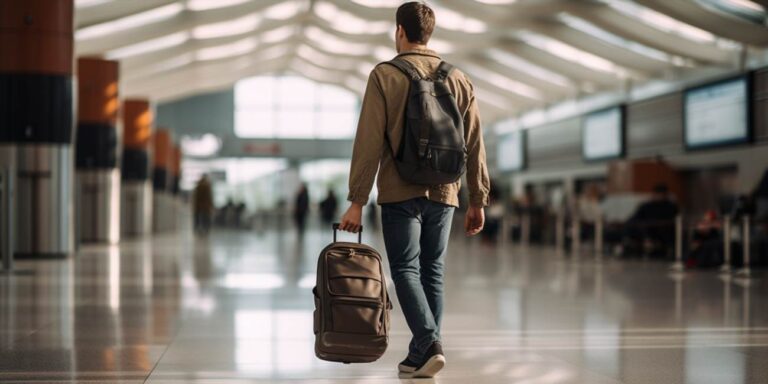Firstly, it’s essential to understand that bringing a camera on a plane is generally allowed both in your carry-on luggage and checked baggage. However, it’s in your best interest to carry valuable and delicate equipment, such as cameras, in your carry-on bag. This way, you have more control over its safety and can prevent potential damage that may occur in the checked baggage compartment.
Security screenings are a routine part of air travel, and your camera gear will go through the X-ray machine along with your other belongings. To expedite this process, it’s advisable to place your camera in a dedicated camera bag that allows easy visibility of the equipment. This helps the security personnel get a clear view of the contents, ensuring a smooth passage through the screening process.
For those wondering about camera accessories such as tripods, selfie sticks, or camera stands, the rules can vary. In general, these items are also allowed but may need to go through the security screening separately. It’s recommended to check with the airline or relevant authorities regarding any specific regulations on these accessories to avoid any surprises at the airport.
When traveling internationally, it’s crucial to be aware of the regulations of both your departure and destination countries. Some places may have restrictions on the type or quantity of electronic devices you can bring, so it’s wise to familiarize yourself with the rules in advance.
Another consideration is the airline’s policies on photography during the flight. While capturing memories is encouraged, using electronic devices during certain phases of the flight may be restricted. It’s important to adhere to the airline’s guidelines and the instructions of the flight crew to ensure a safe and enjoyable journey for everyone on board.
Flying with camera gear: tsa regulations and airline policies
Flying with camera gear requires careful consideration of both TSA regulations and airline policies. It’s essential for photographers and videographers to navigate these guidelines seamlessly to ensure a smooth and stress-free travel experience with their valuable equipment.
When it comes to TSA regulations, it’s crucial to be aware of the rules governing the security screening process. Camera gear is generally allowed in both carry-on and checked baggage, but certain items might require additional screening. For instance, camera batteries are subject to specific rules due to their potential fire risk. It’s advisable to keep spare batteries in their original packaging or use a battery case to prevent short circuits.
Additionally, TSA recommends placing camera equipment in a dedicated bag to streamline the screening process. This not only expedites the security check but also protects the gear from potential damage. Security personnel may ask you to remove larger items, such as camera bodies and lenses, from your bag for closer inspection.
Understanding airline policies is equally important, as carriers may have varying rules regarding the carriage of camera equipment. Most airlines allow passengers to bring camera bags as part of their carry-on allowance, but it’s advisable to check the specific dimensions and weight limits imposed by the airline.
Packing plays a significant role in ensuring the safety of your camera gear during the flight. Consider using padded dividers or foam inserts to protect delicate equipment from potential bumps and jostles. Some photographers opt for hard cases for added protection, especially when checking in their gear.
For larger items such as tripods, it’s essential to check with the airline regarding their carriage. While some airlines allow tripods as part of the carry-on, others may require them to be checked in. Knowing the airline’s policies in advance can help you plan and pack accordingly.
It’s worth noting that some airlines may have specific regulations for photography equipment with lithium batteries. Checking these policies beforehand can save you from last-minute hassles at the airport.
Photographers should also consider the value of their equipment and explore options for additional insurance coverage during travel. This provides an extra layer of protection in case of loss, theft, or damage during the journey.
Packing cameras and accessories for airplane travel

When embarking on an adventure that involves air travel, efficiently packing cameras and accessories becomes paramount. Ensuring the safety of your cherished photography gear requires meticulous planning and consideration of every essential component – from chargers to batteries, memory cards, laptop, and even a drone.
First and foremost, safeguarding your cameras and delicate equipment is a priority. Invest in a durable and well-padded camera bag to shield your devices from the bumps and jostles they might encounter during the journey. Utilizing battery cases for your camera’s power source is a wise move, preventing any accidental short circuits or damage.
When it comes to chargers, consider a universal travel adapter to eliminate compatibility issues. This versatile accessory ensures that your camera, laptop, and other devices can be charged seamlessly, irrespective of your destination. Always double-check the voltage requirements for your chargers to avoid any potential mishaps.
Memory cards are the lifeblood of a photographer, storing precious moments captured through the lens. Prioritize high-capacity and high-speed cards to accommodate the demands of modern high-resolution cameras. Storing them in a dedicated memory card wallet not only keeps them organized but also protects them from dust and damage.
When traveling with a laptop, be strategic in your choices. Opt for a lightweight and compact model that balances performance with portability. Ensure that your laptop bag provides sufficient padding and protection, and consider investing in a portable hard drive for additional storage, especially when dealing with large photo and video files.
For enthusiasts of aerial photography, a drone is an indispensable tool. However, packing a drone for air travel involves careful consideration of regulations and safety measures. Detach the propellers and secure them properly, and carry your drone in a dedicated and sturdy case to prevent any damage during transit.
As you assemble your gear, create a checklist to ensure that no essential item is left behind. This can be a simple list or a detailed table that categorizes each component, including chargers, batteries, memory cards, laptop, and drone. This not only aids in the packing process but also serves as a quick reference point when you’re on the move.
Protecting sensitive photography gear during flights
When embarking on a journey with your photography gear, ensuring the safety of your equipment becomes paramount. Whether you are a professional photographer or an enthusiast, protecting your sensitive gear during flights requires thoughtful consideration and strategic planning.
One indispensable aspect of safeguarding your valuable equipment is investing in a comprehensive insurance policy. This not only provides financial security in case of unforeseen mishaps but also offers peace of mind, allowing you to focus on capturing those perfect moments. Ensure that your policy explicitly covers damages during air travel, including accidental drops or impacts.
Equally crucial is the choice of a sturdy hard case to house your gear. Opt for a case that is not only impact-resistant but also designed to withstand the rigors of air travel. Look for features such as custom foam inserts that can be tailored to fit your specific equipment, providing an extra layer of protection against shocks and vibrations.
Integrating padding into your packing strategy is another vital element in preserving the integrity of your gear. Utilize padded dividers within your hard case to create individual compartments for each piece of equipment. This minimizes the risk of items colliding during transit, reducing the potential for scratches, dents, or other damages.
Recognizing the delicate nature of your equipment is imperative, especially if it is labeled as fragile. Clearly mark your hard case with bold labels indicating its fragile contents. This alerts airline staff to handle your gear with extra care, potentially mitigating the chances of mishandling.
Consider creating a detailed checklist to ensure you have covered all bases before your flight. This can include verifying your insurance coverage, inspecting the integrity of your hard case, and confirming the effectiveness of your padding system. A systematic approach minimizes the risk of oversights and enhances the overall protection of your photography gear.






